An important part of your treatment and recovery after breast cancer surgery is exercise. It can help you:
- Reduce stiffness in your joints.
- Keep movement in your arms and shoulders.
- Make your muscles stronger.
- Get back to doing your daily activities.
Avoid vigorous exercise and sports in the early weeks after surgery. If you were regularly playing sports before, talk with your surgeon about when you may be able to start again.
It's important to still stay active.
Baseline movement: It’s important for you to know how much shoulder movement you had before your breast surgery. This is your baseline movement. It can help you track your recovery.
Before your surgery, go through each of the shoulder exercises so that you know your baseline movement.
The following exercises should be done after all types of breast surgery unless you have had immediate breast reconstruction. If you have had immediate breast reconstruction, speak to your surgeon about the exercises you need to do, and when to start them. If you have any concerns about how well you can move (your level of mobility) or strength, ask for a referral to a physiotherapist.
Note: These exercise instructions refer to your affected side. This is the side where you had your surgery (your unaffected side is the one you did not have surgery on). If you’ve had surgery on both sides, do the exercises on both sides.
Stretching exercises - Week 1
- Start doing your exercises 24 hours after your surgery. Keep doing them until you get back to your baseline movements.
- If you have a drain, you may have more drainage after doing these exercises. This is normal. Make sure the drain is just emptied and securely fastened before you start the exercises.
- It’s normal to feel your skin and tissue pull and stretch a bit with these movements.
- Make sure you take the time to go through the movements of each exercise and do the full exercise.
- Do the exercises 2 to 3 times per day
- 5 to 10 times each exercise
Seated posture
- Sit in a firm chair or on a stool with your back straight and your feet on the floor.
- Keep your chin tucked in and shoulders back towards your spine.
- Tighten your stomach muscles by pulling your belly button in.
- Hold this position for 5 to 20 seconds and then relax. Repeat.
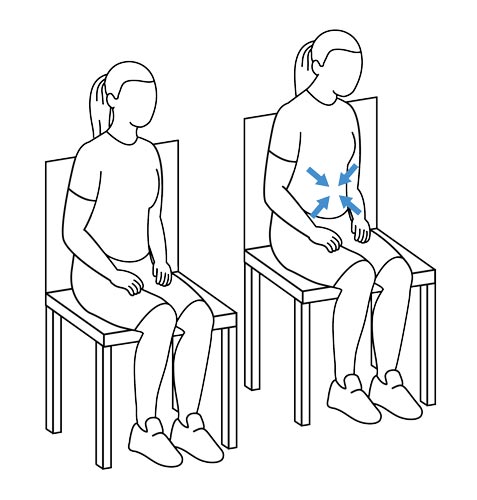
Images adapted with permission of Physiotec
Active hand pump
- Sit with your hands on your lap or lie down on your unaffected side and support your affected arm on a pillow.
- Slowly open and close your hands as far as possible, and repeat.
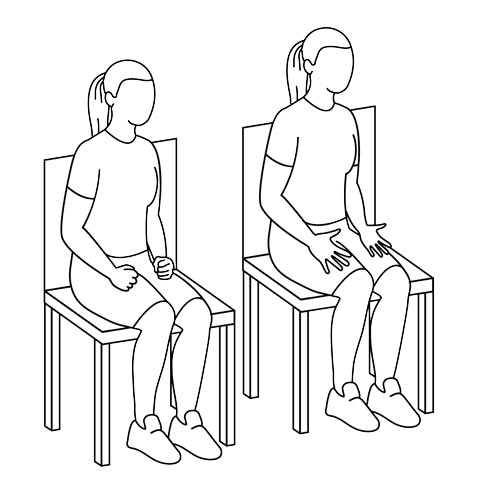
Images adapted with permission of Physiotec
Shoulder shrugs and circles
- Stand or sit.
- Lift both shoulders up towards your ears, then circle them back and down.
- Return to your starting position and repeat.
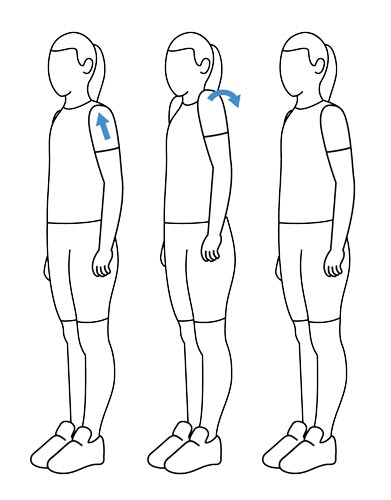
Images adapted with permission of Physiotec
Assisted shoulder flexion
- Lie on your back with your knees bent and both arms by your sides.
- Use the hand on your unaffected side to hold the wrist of your affected arm.
- With your affected elbow slightly bent, gradually raise your arms up and back, slowly going over your head.
- Hold for 5 seconds, and then relax. Return to your starting position and repeat.
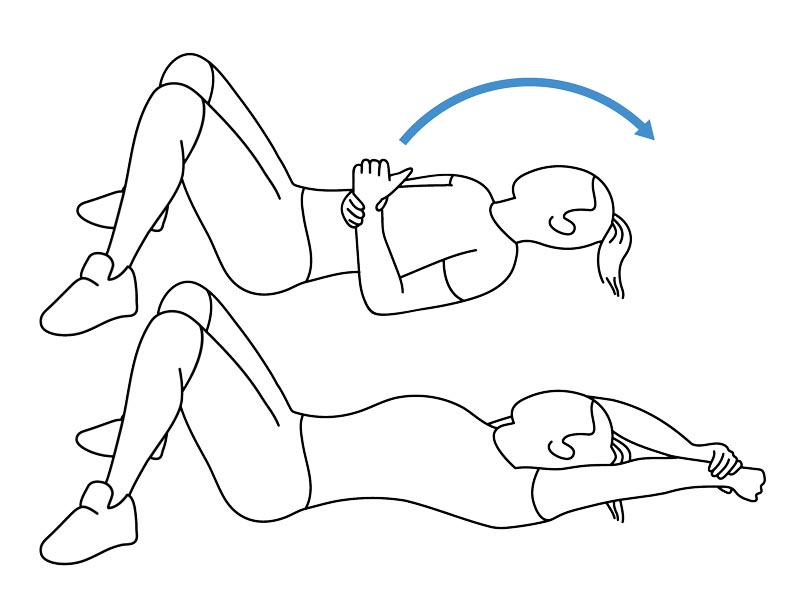
Images adapted with permission of Physiotec
Butterfly stretch
- Lie on your back with your knees bent and clasp your hands together loosely behind your head. Point your elbows towards the ceiling.
- Slowly move your elbows apart and down to the floor.
- Hold for 5 seconds and then relax. Return to your starting position and repeat.
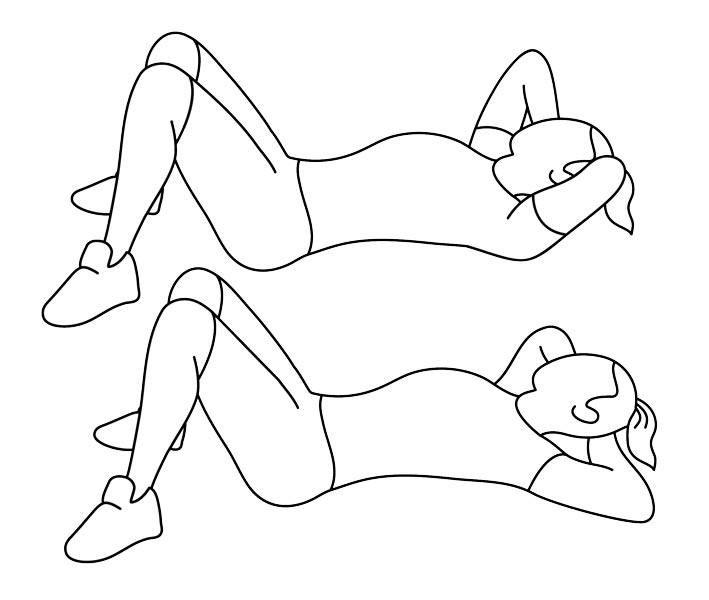
Images adapted with permission of Physiotec
Shoulder abduction
If you have had a mastectomy or axillary lymph node dissection do this exercise near the END of week 1.
- Sit up straight about ½ to 1 meter away from a wall.
- Keep your body straight and your shoulders level.
- Do not shrug your shoulder or lean to the other side.
- Place the fingertips of your affected hand on the wall and with your fingers, climb up the wall slowly, as high as you can.
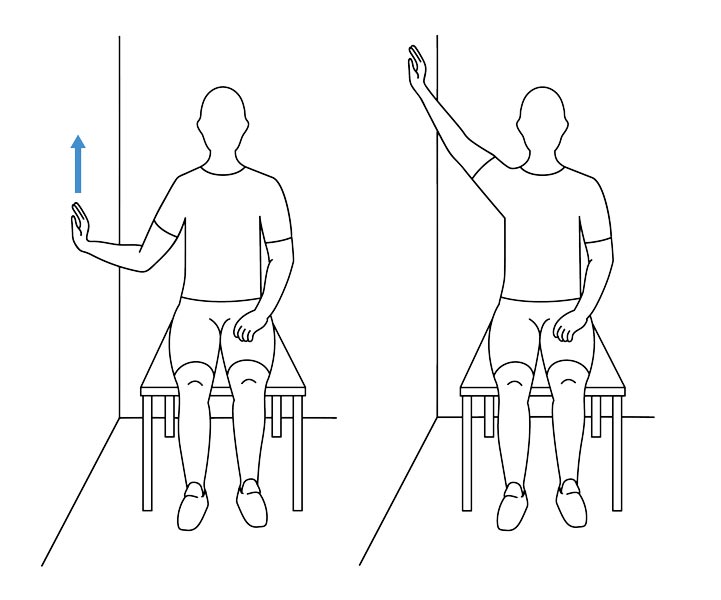
Images adapted with permission of Physiotec
Note: You can start week 2 exercises in week 1, as long as you can do week 1 exercises comfortably.
Stretching exercises - Week 2
These exercises are the next step from week 1 exercises.
- You can continue with the week 1 exercises if your arm and shoulder still feel tight, otherwise the week 2 exercises replace the week 1 exercises.
- The exercises should not be painful, but you will feel a stretch while doing them.
- Some of the exercises are stretches that you hold and some of the exercises should be repeated. Do these exercises 3 to 5 times a day.
- Hold: Hold each exercise for 5 to 20 seconds.
- Repeat: Repeat each exercise 5 to 10 times.
Trunk side bending (repeat)
- Sit in a firm chair with your back straight and your feet on the floor.
- Place your hands behind your head.
- Slowly bend to one side as far as you can until you feel a stretch in your opposite side and under your arm.
- Return to your starting position and repeat on your other side.
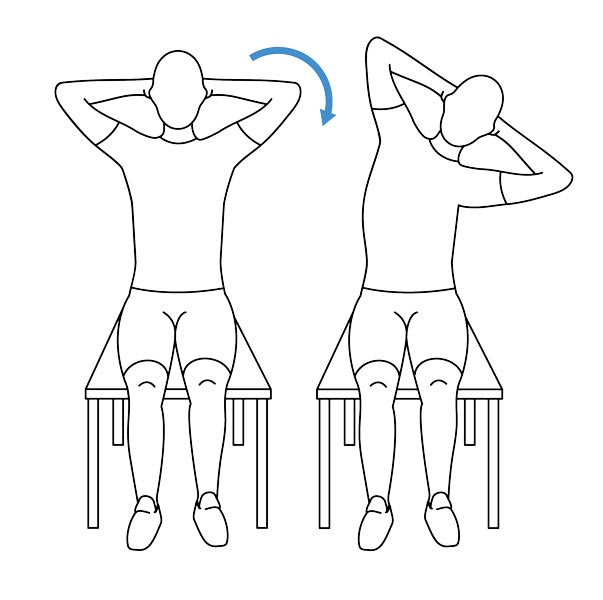
Images adapted with permission of Physiotec
Shoulder flexion stretch (hold)
- Stand behind a chair with both hands on the back of the chair. (The chair is for balance only. You can also use a counter.)
- Back up a few steps and bend forward until you feel a stretch in front of your shoulders.
- Keep your back flat and your elbows softly bent.
- Hold for 5 to 20 seconds and then return to your starting position.
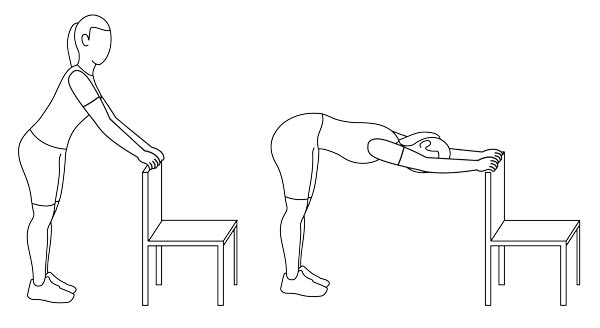
Images adapted with permission of Physiotec
Pectoralis stretch, supine (hold)
- Lie on your back with your knees bent.
- Bring your arms out to your side to 45 degrees.
- Keep your shoulders down and turn your palms face up.
- Hold for 5 to 20 seconds and then relax.
- When you are able, increase to 90 degrees, and then to 120 degrees.
.jpg)
Images adapted with permission of Physiotec
Lower pectoralis stretch (hold)
- Lie on your back with your knees bent.
- Bring your arms out to your side to 120 degrees.
- Hold for 5 to 20 seconds, and then relax.
.jpg)
Images adapted with permission of Physiotec
Shoulder abduction (repeat)
- Sit up straight and look ahead of you with your arms at your sides.
- Face the palm of your affected hand forward and lift your arm out to the side towards the ceiling.
- Keep your elbow slightly bent and your shoulders down.
- Slowly return to your starting position and repeat. You may also move your wrist up and down (wave).
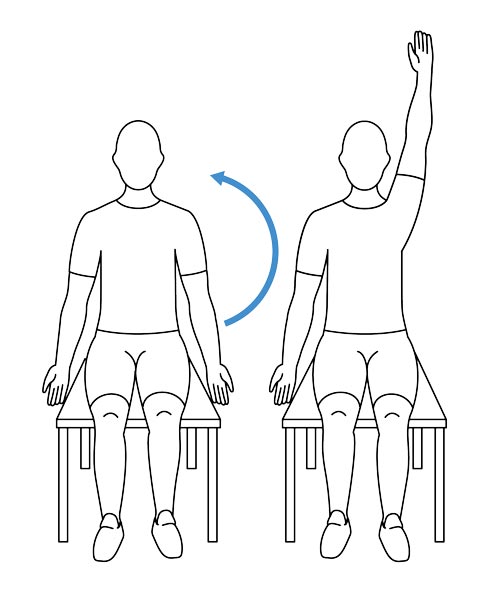
Images adapted with permission of Physiotec
Active shoulder flex: 1 arm (repeat)
- Stand or sit straight with your chin tucked in.
- Pull your shoulder back on your affected side and lift your arm in front of you as high as you can, keeping your elbow slightly bent.
- Slowly return to your starting position and repeat. You may also move your wrist up and down (wave).
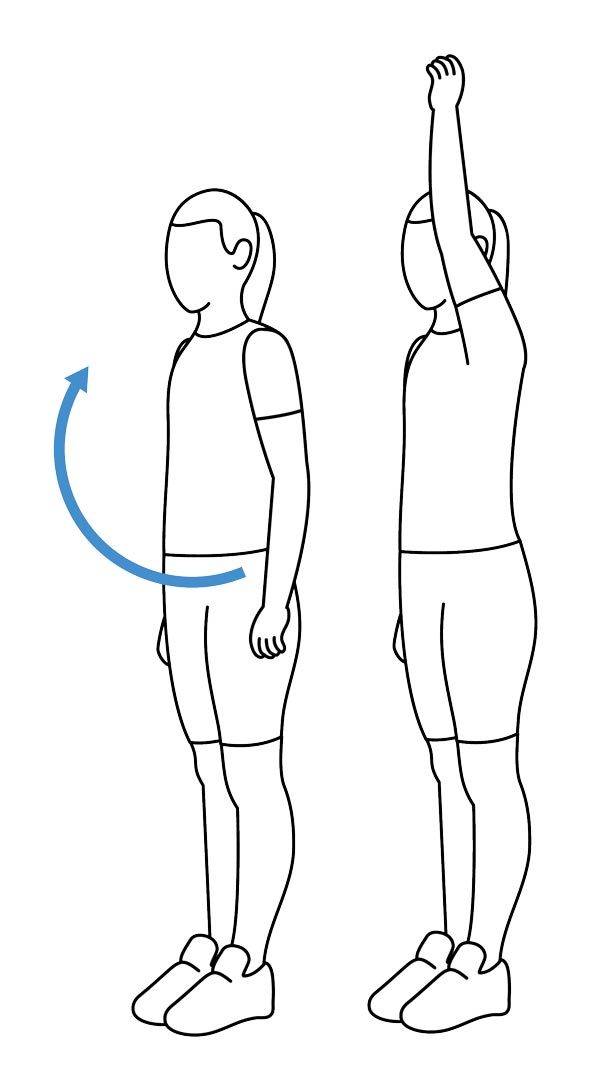
Images adapted with permission of Physiotec
Strengthening exercises:
- These exercises will make your shoulder muscles stronger.
- Start these exercises as soon as your arm on your affected side moves almost as well as you could before your surgery.
- Your pain shouldn’t increase with these exercises.
- Start with a light weight—0.5 to 1 kg (1 to 2 lb.)—or you can use a soup can instead of weights. If you don’t have an elastic exercise band, you can do the third exercise with weights or soup cans.
- Do these exercises up to 3 times a week with a rest day in between.
- Start by doing each exercise 10 times.
- Slowly work up to 2 sets of 10 with a rest in between.
- Your muscles may feel tired from these exercises but the exercises shouldn’t cause pinching or shooting pain in the neck, shoulder, or arm.
Chest press
- Lie on your back with a weight in each hand, your arms at your sides and your elbows bent.
- Straighten your elbows and push your arms up towards the ceiling and directly over your chest.
- Hold for 5 seconds and then relax.
- Slowly return to your starting position and repeat.
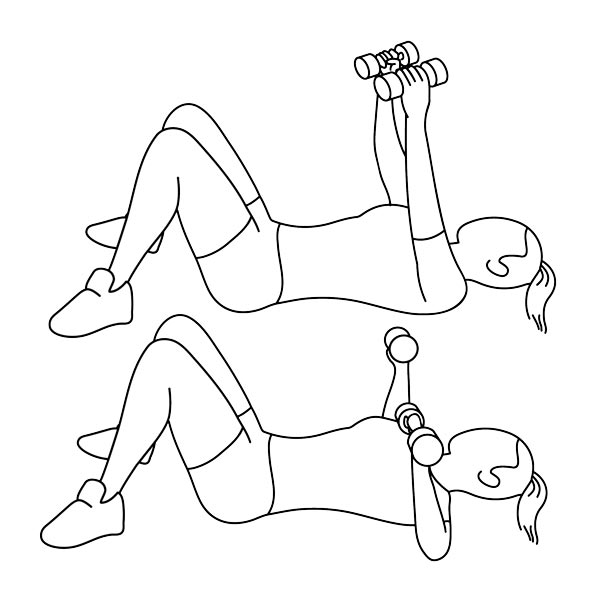
Images adapted with permission of Physiotec
Wall push-ups
- Stand up and place your hands on the wall below shoulder height.
- Bend your arms and slowly lean your upper body forward toward the wall.
- Straighten your arms, keep your trunk in a straight line, push your upper body back to the starting position, and repeat.
- Keep your body in a straight line.
Level 1: Stand half of your arm’s length from the wall.
Level 2: Move farther back from the wall to no more than the length of your shoulder to your fingertip.
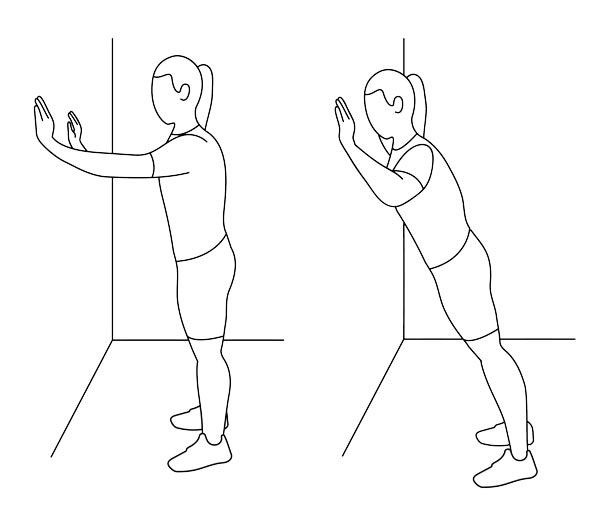
Images adapted with permission of Physiotec
Horizontal abduction with elastic exercise band
- Tie an elastic exercise band at waist level to a firmly planted object in front of you such as a post in your basement or the leg of a heavy table. Use an exercise band that is about 75 cm (30 inches) long.
- Take one end of the elastic exercise band in each hand.
- Bend your elbows slightly and pull the elastic exercise band back by bringing your shoulder blades together and reaching your arms out to the sides.
- Keep your shoulders down and back.
- Slowly return to your starting position and repeat.
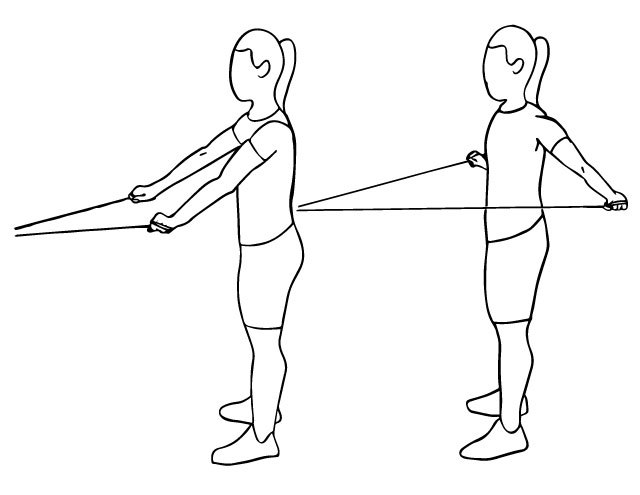
Images adapted with permission of Physiotec
Resisted shoulder scaption
- Stand with your arms at your side, thumbs facing up, and your shoulders back and down. Lift your arms out to the side until they’re at the height of your shoulders and slightly in front of your body.
- Slowly return to your starting position and repeat.
- This exercise shouldn’t pinch in your shoulders.
- When you’re comfortable doing this exercise, add a weight to each hand.
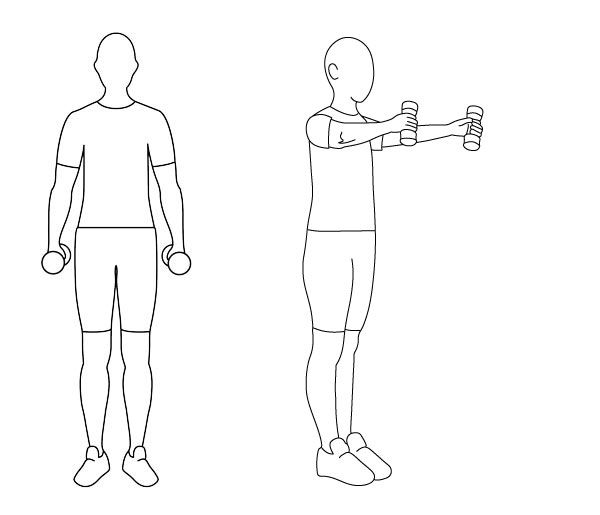
Images adapted with permission of Physiotec
Shoulder flexion with weight
- Stand or sit straight with your chin tucked in, arms at your side, and a weight in the hand of your affected side.
- Pull your shoulder back on your affected side and lift your arm in front of you as high as you can. (Note: if this exercise is too hard with a straight arm, try with a bent elbow.)
- Slowly return to your starting position and repeat.
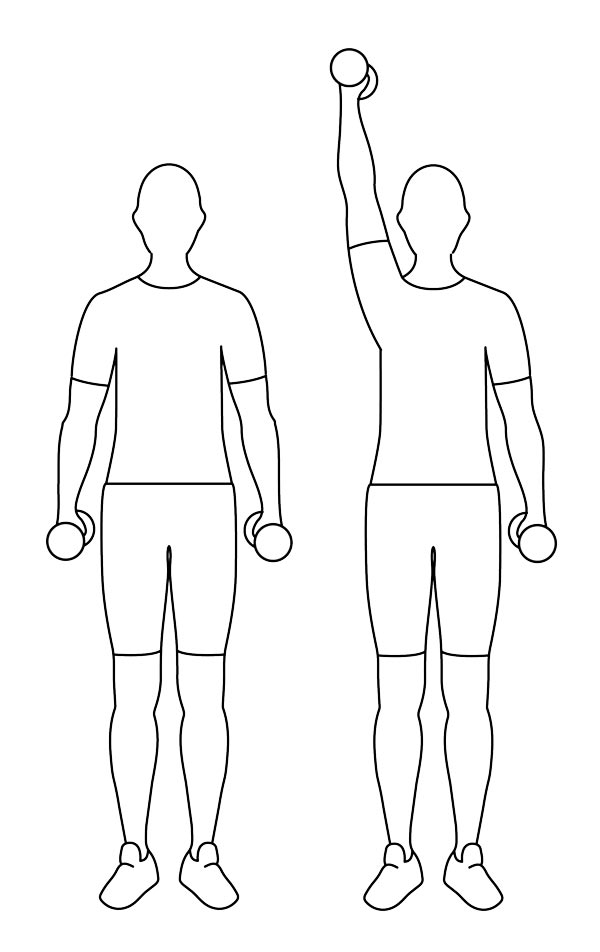
Images adapted with permission of Physiotec
Elbow flexion
- Stand with your arms at your side and a weight in your hand of your affected side. Face your palm inward towards your side.
- Bend your elbow and turn your palm upward and towards your chest.
- Slowly return to your starting position and repeat.
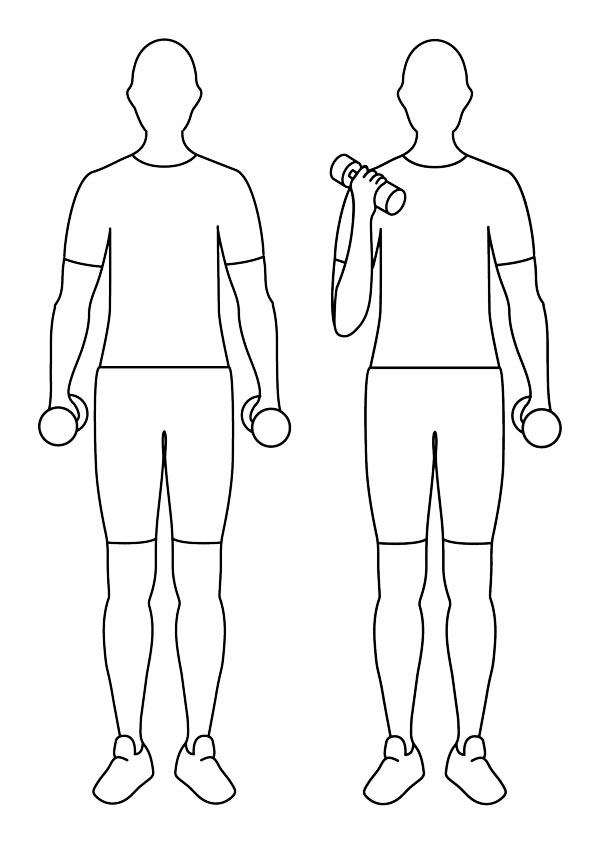
Images adapted with permission of Physiotec
Elbow extension
- Lie on your back with a weight in your hand of your affected side.
- Hold your elbow with your unaffected hand and lift your arm so that your elbow is pointing to the ceiling.
- Raise and straighten your elbow so that your hand is over your shoulder.
- Slowly bend your elbow and lower your hand towards your head.
- Return to your starting position and repeat.

Images adapted with permission of Physiotec
